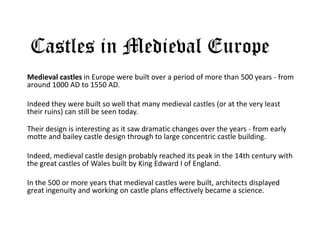Castles in medieval europe Features and adaptations over time
- 1. Castles in Medieval Europe Medieval castles in Europe were built over a period of more than 500 years - from around 1000 AD to 1550 AD. Indeed they were built so well that many medieval castles (or at the very least their ruins) can still be seen today. Their design is interesting as it saw dramatic changes over the years - from early motte and bailey castle design through to large concentric castle building. Indeed, medieval castle design probably reached its peak in the 14th century with the great castles of Wales built by King Edward I of England. In the 500 or more years that medieval castles were built, architects displayed great ingenuity and working on castle plans effectively became a science.
- 2. Hill FortsThe history of the castle goes back to the Hillforts of the Bronze Age ( 1800 - 600 BC ). Small Hillforts developed out of a need to defend small homesteads and even small villages Hillforts were built as an enclosed area which was used for: • A meeting place for trading • A permanent home • A safe retreat against raids from other tribes • Shelter for rising population levels • Shelter against harsh winters and wild animals • a place for safe animal compounds or enclosures What weaknesses did they have?
- 3. Better Castles: Motte and Bailey Developed from hillforts around the 11th century. They allowed a safer place for villages to go to when attacked. They also provided a larger fortified village. Features: • Hill fort • Moat (motte) • Gatehouse (bailey) • Walled village • Bridge • What weaknesses were there?
- 4. Towers • Towers were impressive buildings to defend a country and to dominate the population • Overhanging towers provided clear lines of sight for the archers • Attackers had to fight uphill • Spiral Staircases made it hard to swing a sword or smash in the gate • Supplies of food and water could be kept in the cellar Weaknesses?
- 5. Curtain Wall Castles • The need to include surrounding buildings and allow for space to accept refugees led to concentric castles with a series of progressively smaller walls. • The attackers would not only have to make more breaches but the design of the walls could force them into areas where they could be massacred. • A particularly effective development was the barbican which is a walled courtyard in front of the castle gateway.
- 6. Attacking Medieval Castles There were three main ways to attack a medieval castle and overcome its defences: • Starvation - works well on geographically isolated castles and castles which can be easily surrounded. Similar to denial of the water supply. Difficult when access can be made along a wide river or by approaching from the sea. • Mining - some of the most stubborn castles were breached by tunnelling under the walls and starting fires which would lead to a collapse of the supporting earth. • Treachery, surprise and stupidity - Chateau Gaillard was breached through an unguarded chapel window and Beziers fell when the defenders rushed out enthusiastically leaving the gate undefended. • The other means of castle attack tended to involve machines, either stone throwing like a trebuchet or a battering ram.








